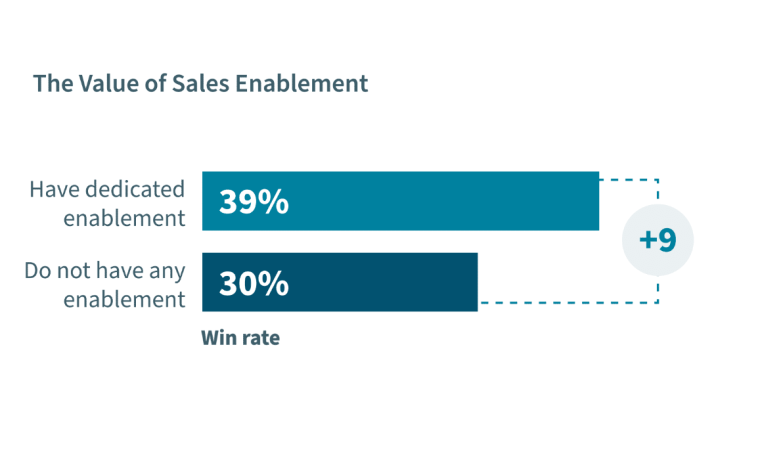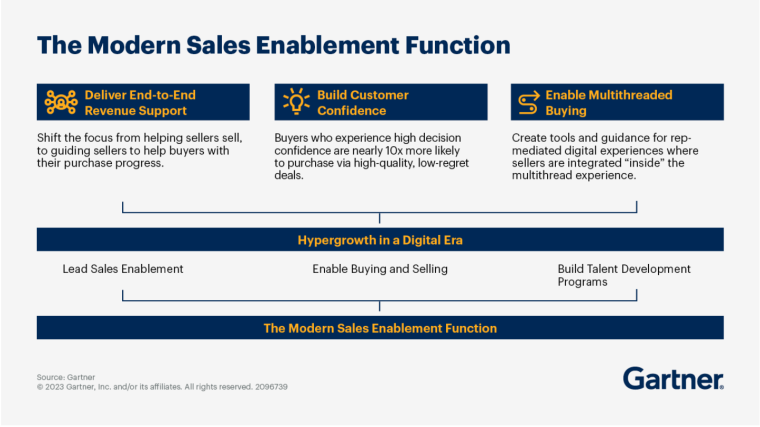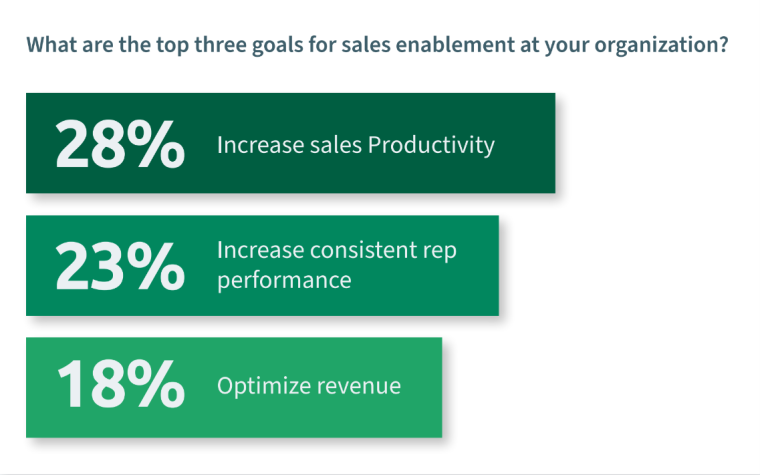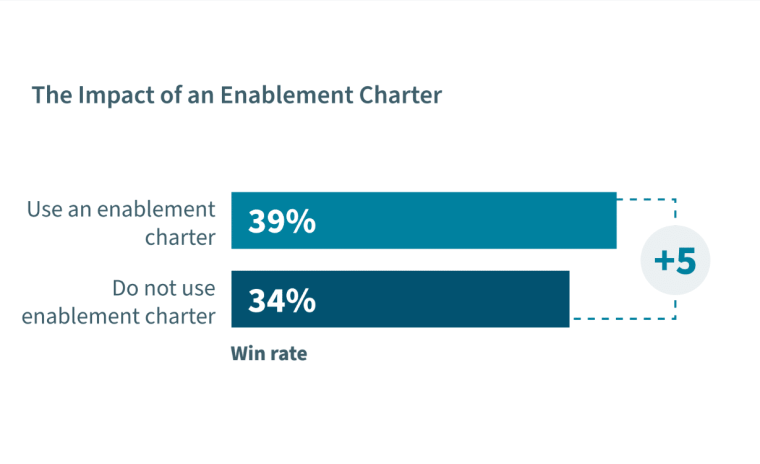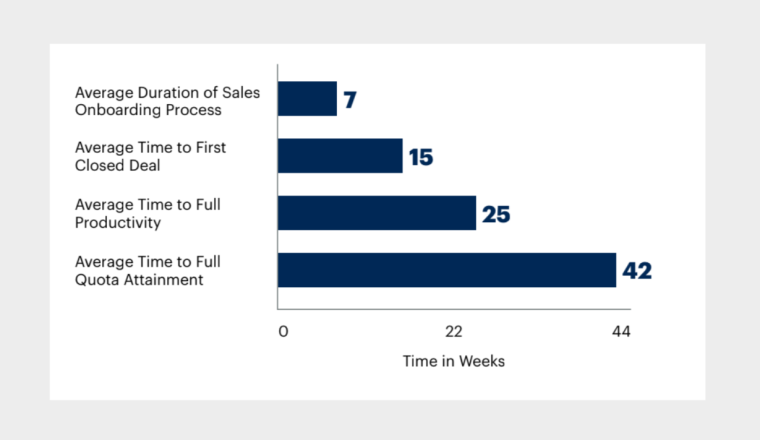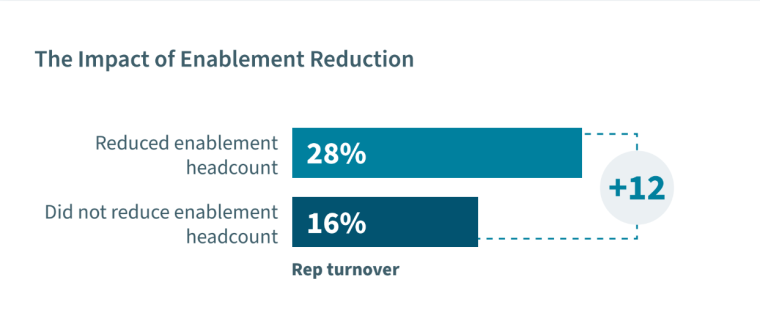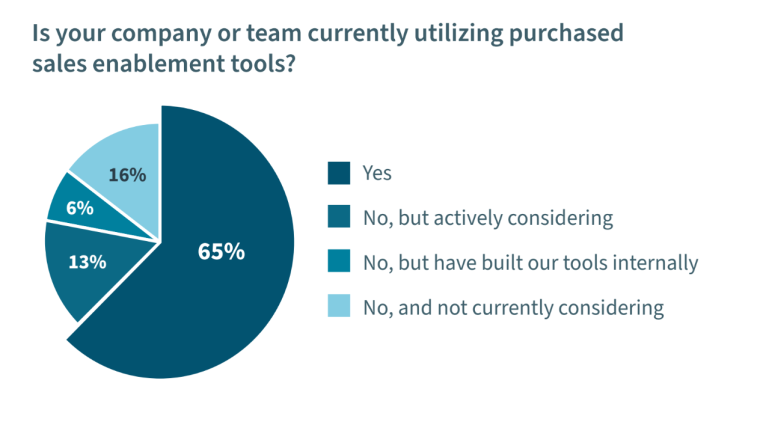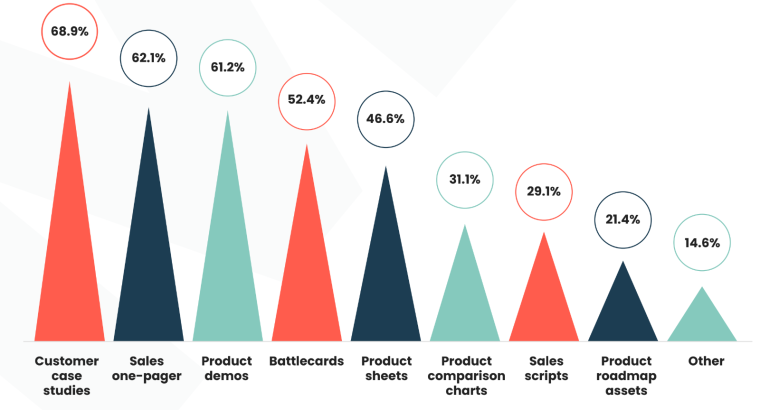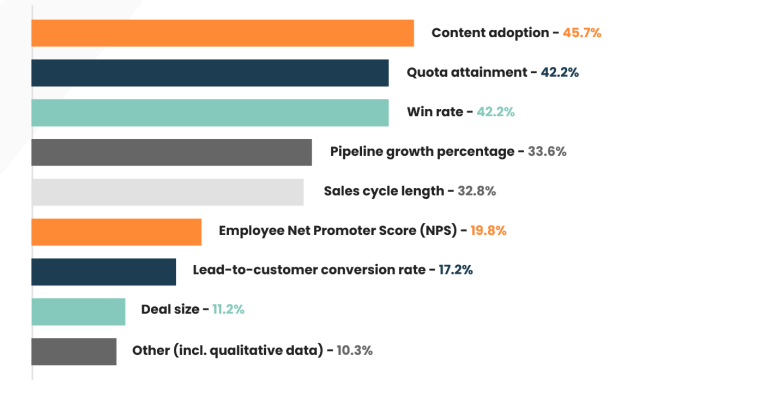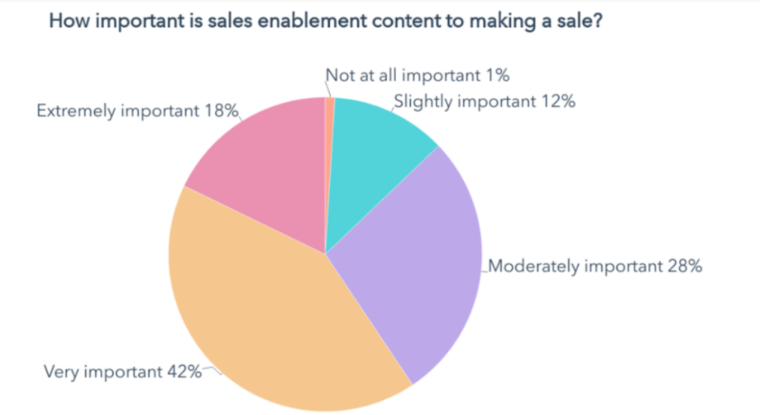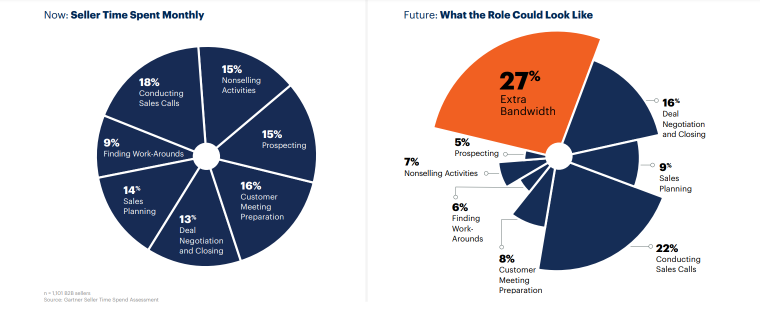In an increasingly complex and unpredictable economic landscape, businesses need to ensure their sales teams are firing on all cylinders.
Understanding sales enablement statistics, which provide valuable insights that encompass the processes, tools, and resources that help sales reps thrive, is the key to boosting sales productivity, streamlining sales processes, and optimizing revenue.
To steer your sales strategy towards success, we’ve gathered all the latest statistics and insights on sales enablement.
Dive in as we define sales enablement, explore its effectiveness, and explain how to incorporate it into your operations.
Key Sales Enablement Statistics
- Sales enablement adoption has seen a significant 20% year-over-year increase.
- Effective sales enablement makes organizations 45% more likely to improve their sales efficiency.
- 65% of leaders plan to increase their sales enablement budget over the next two years.
- 60% of sales leaders feel that having dedicated sales enablement support is extremely important to their sales operations.
- Sales enablement teams with integrated technology stacks report 19% higher quota attainment than teams that use multiple disconnected tools.
What Is Sales Enablement?
Sales enablement is the process of helping sales reps sell more effectively by providing them with the right resources, content, processes, and technology. Effective sales enablement provides organizations insight into what works and makes them 45% more likely to improve their sales efficiency.
A 2023 report by Sales Enablement Pro confirmed that sales enablement adoption has seen a significant 20% year-over-year increase. Sales enablement has become a dynamic force for organizations to empower their sales force and improve their sales performance.
Due to its impact, sales enablement is now a key function with 90% of respondents surveyed revealing that they have a dedicated person, program, or function for sales enablement.
According to research by Seismic, businesses that effectively implement sales enablement achieve a 32% increase in meeting their sales quotas and do so up to seven weeks sooner.
Sales enablement helps go-to-market (GTM) teams drive greater sales success by:
- Encouraging sales and marketing alignment
- Ensuring brand integrity and consistency
- Closing more deals
83% of buyers said they were more loyal to companies that provide consistency across departments in a 2022 Salesforce survey. Sales enablement benefits buyers by shifting the focus from the sales funnel to the buyer’s journey, ensuring buyers receive personalized solutions and informed post-sale support. Additionally, when enablement effectively streamlines processes to unify the buyer experience, organizations report 12% higher win rates.
More than 20% of sales professionals in an LXA survey reported the top reason prospects back out of deals is the length of the sales process. Sales enablement provides the solutions and processes to shorten sales cycles and drive higher close rates. It also prepares reps for the following sales challenges:
- 57% of buyers now prefer to engage with companies through digital channels.
- Companies report that nearly one-third of the deals they close are now completely virtual.
- 82% of sales professionals surveyed in a Salesforce report say they’ve had to quickly adapt to virtual selling and other new ways of working with 69% admitting that selling is harder now.
- With buyers going through 57% of the buyer journey alone, sales reps have to better understand their products, customers, and the market more deeply, to bring more value to each conversation.
How to Implement Sales Enablement
Implementing sales enablement involves creating and executing a tailored sales enablement strategy. This involves gaining a clear understanding of your sales team, your business’s overall goals, and your prospects’ buying traits. It also involves:
- Establishing clear sales enablement goals.
- Developing a sales enablement charter.
- Investing in a dedicated sales enablement team.
- Selecting appropriate platforms and tools.
- Investing in the right sales enablement content.
- Investing in ongoing sales onboarding, training, and coaching.
- Measuring and tracking sales enablement performance.
Establish Sales Enablement Goals
The first step to formulating an effective sales enablement strategy is setting the right goals. Establishing sales enablement goals provides a clear understanding of what needs to be achieved, how to measure success, and where to focus your resources. In fact, 81% of organizations agree that clear enablement goals help to improve the efficiency of revenue teams.
According to a 2023 Sales Enablement Pro report, some of the most common sales enablement goals for 2023 included:
- Increasing sales productivity – 28%
- Increasing sales rep performance – 23%
- Optimizing revenue – 18%
While the goals listed above are a great starting point, it’s important to consider your performance as well as the state of your sales to come up with goals that speak to your business’s specific needs.
Develop A Sales Enablement Charter
After formulating goals, you’ll need to establish a charter to guide your sales enablement strategy. This kind of charter:
- Defines the mission, purpose, and role of the sales enablement function.
- Outlines who owns sales enablement as well as the sales enablement team’s alignment with marketing teams and product management.
- Describes the enablement team’s objectives and who they will support.
- Details specific sales enablement processes.
- Details the sales enablement resources, tools, and technology to be used.
- Outlines how success will be measured and tracked.
A sales enablement charter functions like an agreement between the enablement team and the go-to-market team (sales reps, leaders, marketing, and other customer success staff). It encourages better teamwork, clearer expectations, and a more efficient sales enablement process.
Structuring your enablement team with a formal charter increases the likelihood of stakeholder satisfaction by 44%.
Additionally, organizations that use a formal enablement charter report 5% higher win rates. They’re also twice as likely to experience an increase in both win rate and quota attainment.
Ongoing Training and Coaching
The right sales onboarding, training, and coaching prepares reps for success, equipping them with the skills they need to meet the demands of a competitive sales market.
14% higher win rates are reported by organizations when sales managers effectively coach their reps. These organizations are also 10% more likely to experience high rep engagement.
Sales training ensures reps understand your products, the market, and effective sales techniques, while coaching ensures they receive personalized guidance to improve their selling abilities.
When using sales play tools, reps are 15% more likely to understand how to navigate different sales scenarios, and teams report a 3% increase in average win rates.
Ongoing, data-driven training and coaching programs help sales enablement managers understand winning behaviors, while sales coaching assessments help them identify skill gaps. Additionally, when sales managers can effectively coach reps to reinforce desired behaviors, sellers are 40% more likely to be confident in their abilities and organizations report 14% higher win rates.
Organizations can reduce the average 25 weeks it takes new sales hires to reach full productivity by dedicating 6 weeks to onboarding. According to Gartner, new sales hires are more productive and efficient when they have a longer onboarding period.
In terms of the optimum frequency for sales training, a majority of sales enablement leaders (30.2%) in a Product Marketing Alliance report hold monthly training sessions for their sales enablement teams, while:
- 19.4% hold training sessions whenever a new product is due to launch.
- 15.5% say quarterly training sessions work.
- 12.6% say they hold weekly training sessions.
A Dedicated Sales Enablement Team
More businesses are realizing the strategic impact of dedicated sales enablement teams. For example, organizations are 57% more likely to experience high buyer engagement when they have dedicated sales enablement teams.
When asked if having such a team increased the overall success of sales efforts and performance, 92% of respondents in a 2023 Sales Enablement Pro report agreed.
According to the same report, sales enablement teams continue to grow in size, with the number of teams consisting of over six members increasing by 63% year-over-year to almost 50% in 2023. This is because the extra team members are worth the cost.
Organizations with a reduced enablement headcount report 12% more rep turnover and are 10% more likely to experience decreased revenues. On the other hand, teams with six or more members report 14% higher quota attainment compared to teams with two to five members.
The good news is that even small changes to your enablement team headcount can make a massive difference — every additional enablement team member results in a 3% increase in average win rates.
Sales Enablement Tools and Tech
Enablement teams with consolidated, well-integrated technology stacks report 19% higher average quota attainment than teams that use multiple disconnected tools.
Having these tools in place can empower sales enablement teams, boost organization-wide alignment, and drive business impact. Sales teams use an average of 10 tools to close deals. The top tools used by sales organizations include:
- Sales reporting/analytics.
- Customer relationship management (CRM) systems.
- Account and contact management.
- Mobile sales apps for employees for employees.
- Sales forecasting tools.
Organizations that leverage proven sales enablement tools are 4 times more likely to effectively provide insights into what works to ensure sales rep consistency.
Enablement tools also help improve the rep experience. Organizations that use sales enablement tools are 8 times more likely to have highly engaged reps, which, in turn, drives higher sales performance.
Sales Enablement Content Statistics
Sales enablement content includes the guides, scripts, and other sales enablement materials that:
- Help sales teams understand products and markets better.
- Give sales reps the confidence to sell more effectively.
- Help answer customer questions and address their concerns.
- Improve sales conversations and help sales reps close deals more effectively.
| Seller Stage | Enablement Content Examples |
| Prospecting |
|
| Qualifying |
|
| Needs Assessment |
|
| Proposals |
|
| Closing |
|
| Follow-up |
|
Sales reps empowered with the right content and training achieve 32% higher sales quota attainment. Additionally, an enhanced go-to-market strategy alignment encouraged by sales enablement delivers 38% higher win rates and 24% faster revenue growth.
Sales reps tend to bring in 20% or more in additional revenue when sales content is available at the right time in the sales cycle. In a sales organization lacking an effective content management system, sales representatives can spend up to 10 hours per week searching for, comparing, or revisiting content for sales communication. This is valuable time that could be better spent interacting with prospects and closing deals.
68.9% of respondents in a Product Marketing Alliance report identified customer case studies as the most effective sales enablement content, followed by:
- Product demos at 61.2%
- Sales one-pagers at 62.1%
- Battle cards at 52.4%
Sales scripts (29.1%) and product roadmap assets (21.4%) were said to be the least effective. However, this isn’t to say that you should dismiss them; instead, work with your sales reps to establish what content works best for your sales enablement program.
Measure and Track Performance
No sales enablement strategy is complete without a plan to measure and track performance. KPIs and metrics are the key to understanding the effectiveness of your efforts and being able to make informed decisions that contribute to sales enablement success.
Showcasing the value and effectiveness of sales enablement strategies:
- Justifies additional investments in programs and headcount.
- Enables leadership to assume more trusted and strategic roles.
- Encourages buy-in from cross-functional peers, which in turn strengthens collaboration across the organization.
When asked about the metrics they used to measure enablement performance, respondents in a 2022 Sales Enablement Collective report said:
- Content adoption – 45.7%
- Quota attainment – 42.2%
- Win rate – 42.2%
- Pipeline growth percentage – 33.6%
- Sales cycle length – 32.8%
In terms of measuring rep or sales team performance, 73.3% of respondents said they looked at win/close rates, 45.7% looked at time to quota, and 37.1% looked at content usage.
Does Sales Enablement Work?
Based on hard data, sales enablement works. Since 2015, sales enablement adoption has skyrocketed by over 343%. Sales enablement has become such a core function that 65% of leaders plan to increase their sales enablement budget over the next two years.
Organizations that have successfully implemented sales enablement report a 9% increase in average win rates and an annual sales rep turnover of just 11.9% compared to 19.5% for those that haven’t. They also report the following results in an Oracle survey:
- 49% win rate on forecasted deals.
- 60% higher customer retention rate.
- 84% achievement rate for sales quotas.
- 14% increase in deal size.
- A 2x increase in revenue.
- 33% reduction in ramp time for new hires.
Further, organizations with sales enablement processes or practices in place for more than two years report a 7% improvement in win rates. They’re also 50% more likely to experience high buyer engagement.
| Sales Enablement KPIs/Metrics | Description |
|---|---|
| Lead Conversion Rate | Measures the percentage of leads converted to opportunities |
| Sales Cycle Length | Time taken to close a deal from the first contact |
| Average Deal Size | The average monetary value of each closed deal |
| Win Rate | Percentage of opportunities that turn into sales |
| Revenue per Sales Rep | Total revenue generated divided by the number of sales reps |
| Opportunity-to-Win Ratio | Number of opportunities created vs deals won |
| Quota Attainment | Percentage of sales reps meeting or exceeding quota |
| Customer Churn Rate | Percentage of customers lost in a specific period |
| Customer Lifetime Value (CLV) | Predicted revenue from a customer throughout the relationship |
| Customer Acquisition Cost (CAC) | Cost to acquire a new customer |
| Customer Satisfaction Score | Measures customer contentment post-purchase |
| Email Open Rate | Percentage of opened sales emails |
| Call-to-Meeting Rate | Percentage of calls leading to a sales meeting |
| Time Spent on Content | Time sales reps spend using or creating content |
| Sales Training Completion Rate | Percentage of completed sales training sessions |
According to a 2023 Hubspot report, 60% of sales leaders felt that having dedicated sales enablement support was ‘very important’ or ‘extremely important’ to their sales operations. Additionally, sales reps at companies with dedicated enablement teams performed better and were more likely to reach their goals.
Even professionals who aren’t part of sales enablement leadership consider sales enablement important. Among business executives, 63% say that sales enablement meets or exceeds expectations.
Sales Enablement Technology Statistics
Enablement technology is widely used by 65% of organizations, representing a 5% increase year over year. According to a Hubspot report, 29% of sales professionals want to leverage technology to make their sales process more efficient.
And some of the most popular tools they are using to do so in 2023 include:
- Troops
- Zoho
- LeadIQ
- LinkedIn Sales Navigator
- HubSpot CRM
As per a 2023 report by Seismic, the use of sales enablement technology was gaining popularity, with 82% of survey respondents stating that they used it on the job. A further 99% of respondents agree that sales enablement platforms make their jobs easier. Other key insights include:
- 80% of respondents state that sales enablement technology frees up time to focus on revenue-generating activities, saving them close to two workdays to focus on customer needs.
- 97% of respondents say enablement technology gives them quick access to content, information, or coaching and helps them interact with clients from a more informed perspective.
- 68% of respondents say that having quick access to information and content helps them feel more confident in their skills.
On the other hand, of those who do not use sales enablement tools:
- 36% admit that their organizations struggle with client retention.
- 97% say they’re often (19%) or sometimes (78%) unable to locate the content they need.
- 91% say a lack of sales enablement tools makes them feel less productive.
Choosing the right sales enablement platform can have a significant impact on success. In fact, sales enablement practitioners who leverage a sales enablement platform report win rates that are 7% higher than those who don’t.
According to HBR, close to 50% of sellers feel overwhelmed by the number of technologies needed to do their work. As a result, they’re 43% less likely to meet their quotas. When evaluating sales enablement tools and technologies, determining the value they add to your sales processes is crucial.
Sales teams should be able to integrate sales enablement software into their workflow seamlessly. Rather than overwhelm sales reps, tools must empower them to be more efficient and productive.
Sales Enablement Tool Success Rates
83% of sales enablement professionals use CRM systems. CRM systems help sales teams build and maintain strong relationships with buyers. Businesses that implement tools like HubSpot’s CRM for sales enablement report conversion rate increases that are up to 20% higher.
Using Gong, an AI revenue enablement tool:
- Tinuiti achieved 50% more recurring revenue from cross-selling.
- Diligent increased its close rates by 7.4% for Gong-influenced calls and reduced the time for reps to hit quota by 3 weeks.
- Mintel increased its win rates by 34%.
- ComplyAdvantage decreased ramp time by 50%.
Through Highspot’s unified enablement solution:
- DocuSign achieved a 10% decrease in sales cycle time and a 20% increase in average deal size.
- Office Depot increased content efficiency by 86%.
- The Trade Desk experienced 75% year-over-year growth.
Approximately 73% of organizations report ramp-up times of between 1 and 6 months, while a third report ramp-up times of 3 to 6 months. Using WorkRamp, Reddit cut its sales ramp time by 33%.
By using Seismic to transform its sales enablement, Elekta achieved a 350% increase in sales content adoption.
AI in Sales Enablement Statistics
Only 33% of sales organizations currently use artificial intelligence (AI). In the next two years, an additional 20% of organizations plan to do so.
Research suggests that high-performing sales teams are 1.9x more likely to use AI than underperformers.
80% of sales leaders and professionals say AI has improved the use of reps’ time. The use of AI in sales enablement could give sellers up to 27% more time to focus on what matters most.
It has the potential to change how sales teams work through:
- Simple automation: Basic automation tools and AI technologies that assist with routine tasks to boost sales effectiveness and efficiency.
- Assisted selling: AI-assisted automation to improve sales productivity, prioritization, and execution.
- Automated selling: AI-powered virtual assistants to improve decision-making, reduce human error rates, and streamline execution.
- Autonomous selling: Technology could automate the entire sales cycle, allowing sellers to act as strategic overseers.
84% of respondents in a Gartner survey said that their systems provided advice on the next-best actions to take with potential customers. AI is commonly used for prescriptive recommendations, such as next-best actions or recommended content for sellers to share. It’s also used in training and coaching to determine sales rep sentiment or skill level.
Sales leaders ranked voice of the customer (VoC) analytics methods among the most anticipated technologies in the two years from 2023. Other key technologies leaders are excited for include:
- Predictive analytics (85%)
- Digital experience analytics (84%)
- Customer journey analytics (83%)
How to Measure Sales Enablement Success
To gauge the effectiveness of your sales enablement initiatives, you must focus on metrics that align with your business objectives.
Here are key ways to measure success:
- Quota Attainment Rates: Evaluate the percentage of sales reps meeting or exceeding their quotas. An increase indicates a well-executed enablement strategy.
- Win Rates: Track the ratio of closed deals to opportunities. Improved win rates are a direct reflection of enhanced sales enablement.
- Time to Productivity: Measure how quickly new hires reach full productivity. A shorter ramp time often results from effective onboarding and training programs.
- Sales Cycle Length: Assess the time it takes to close deals. Streamlined processes and better-equipped reps typically shorten sales cycles.
- Content Usage: Monitor how frequently and effectively sales reps use the resources provided. High usage rates suggest that content is relevant and impactful.
- Customer Retention and Expansion: Look at repeat business and upselling or cross-selling success rates to evaluate how well sales enablement supports long-term relationships.
Mistakes to Avoid in Sales Enablement Campaigns
While sales enablement can transform your organization, common pitfalls can derail its effectiveness. Here’s what to watch out for:
- Lack of Clear Objectives: Without defined goals, it’s difficult to measure success or provide direction to your sales enablement strategy.
- Overlooking Team Alignment: Misalignment between sales and marketing teams leads to inconsistent messaging and wasted resources. Ensure collaboration across departments.
- Insufficient Training and Coaching: Failing to provide ongoing training leaves sales reps unprepared for evolving market dynamics, resulting in lost opportunities.
- Neglecting Content Management: Reps spending excessive time searching for resources can reduce productivity. Invest in tools that make content easily accessible.
- Ignoring Analytics and Feedback: A lack of data-driven insights means missed opportunities to refine your strategy. Regularly track performance and incorporate feedback.
- Overloading with Tools: Too many disconnected tools can overwhelm your sales reps, leading to inefficiency. Focus on a consolidated, user-friendly tech stack.
- Failure to Scale: Not updating your strategy or resources to match team growth can lead to inefficiencies and missed targets.
Conclusion
Sales enablement is a powerful lever for improving sales performance, but its success hinges on strategic implementation and ongoing refinement.
By measuring key metrics, staying ahead of trends, and avoiding common mistakes, organizations can ensure their enablement efforts deliver measurable impact and drive long-term growth.
